Technical Report Reviewing Waste Legislation in UK and Hong Kong
VerifiedAdded on 2020/06/04
|12
|2860
|77
Report
AI Summary
This technical report provides a comprehensive comparison of waste management legislation in the UK and Hong Kong. It begins with an introduction outlining the scope of the report, which focuses on controlling waste management, waste reduction strategies, and the implementation of new technologies. The report delves into a detailed comparison of the legislative frameworks of both regions, examining key regulations such as the EU Waste Framework Directive, Environmental Protection Act 1990, and the Hazardous Waste Regulation 2005 in the UK, and the Waste Reduction Framework Plan and Hong Kong Blueprint in Hong Kong. It explores waste categorization, including hazardous, construction, and municipal solid waste, and analyzes the effectiveness of various waste management techniques, including waste exemption and MSW charging. The report further discusses effective controlling methods, strategies for waste reduction, and the implementation of new technologies such as Anaerobic digestion, Gasification, and Gas Plasma. The conclusion summarizes the key findings, highlighting the challenges faced by both regions and the importance of sustainable waste management practices. The report emphasizes the importance of moving towards a zero waste economy and the role of government initiatives in promoting waste reduction, reuse, and recycling.
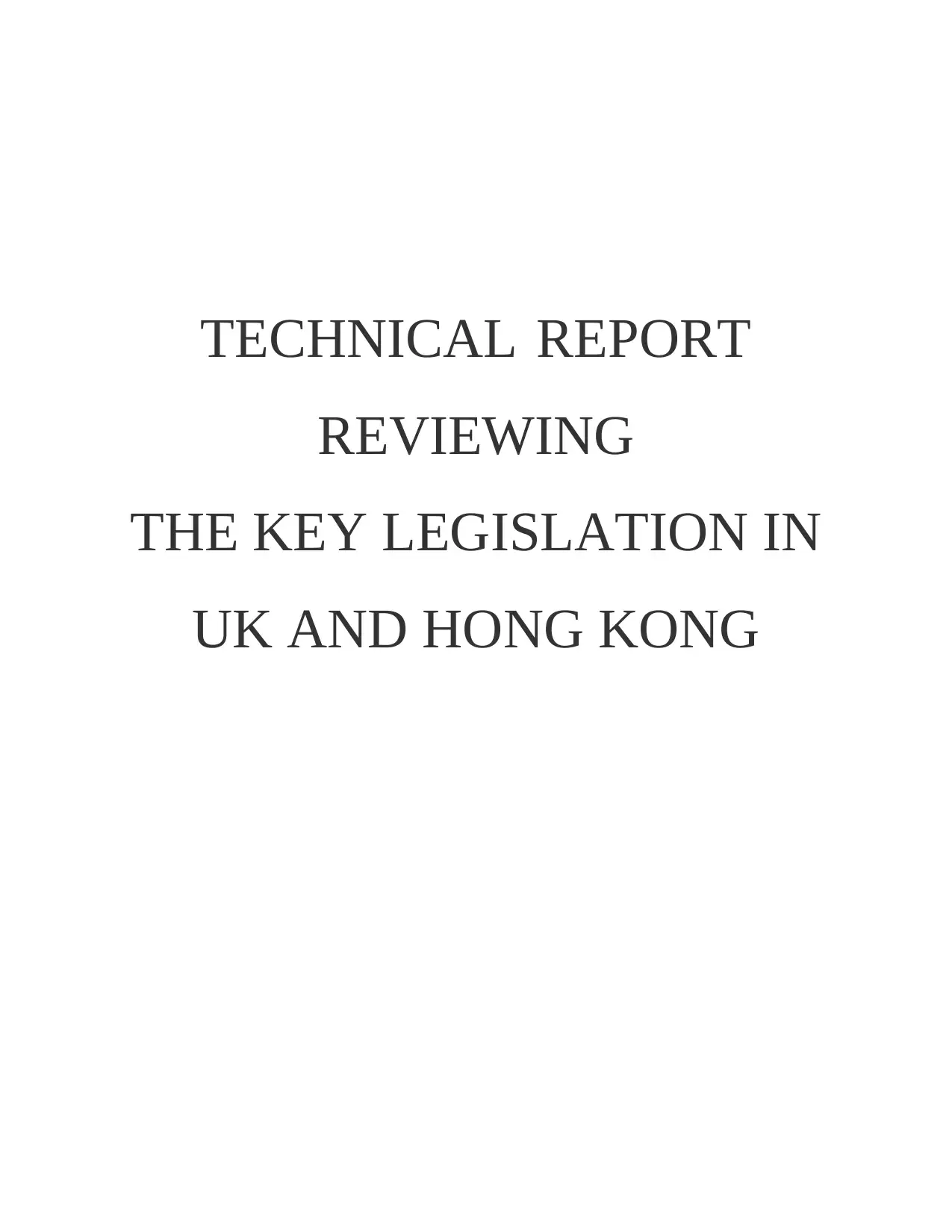
TECHNICAL REPORT
REVIEWING
THE KEY LEGISLATION IN
UK AND HONG KONG
REVIEWING
THE KEY LEGISLATION IN
UK AND HONG KONG
Paraphrase This Document
Need a fresh take? Get an instant paraphrase of this document with our AI Paraphraser
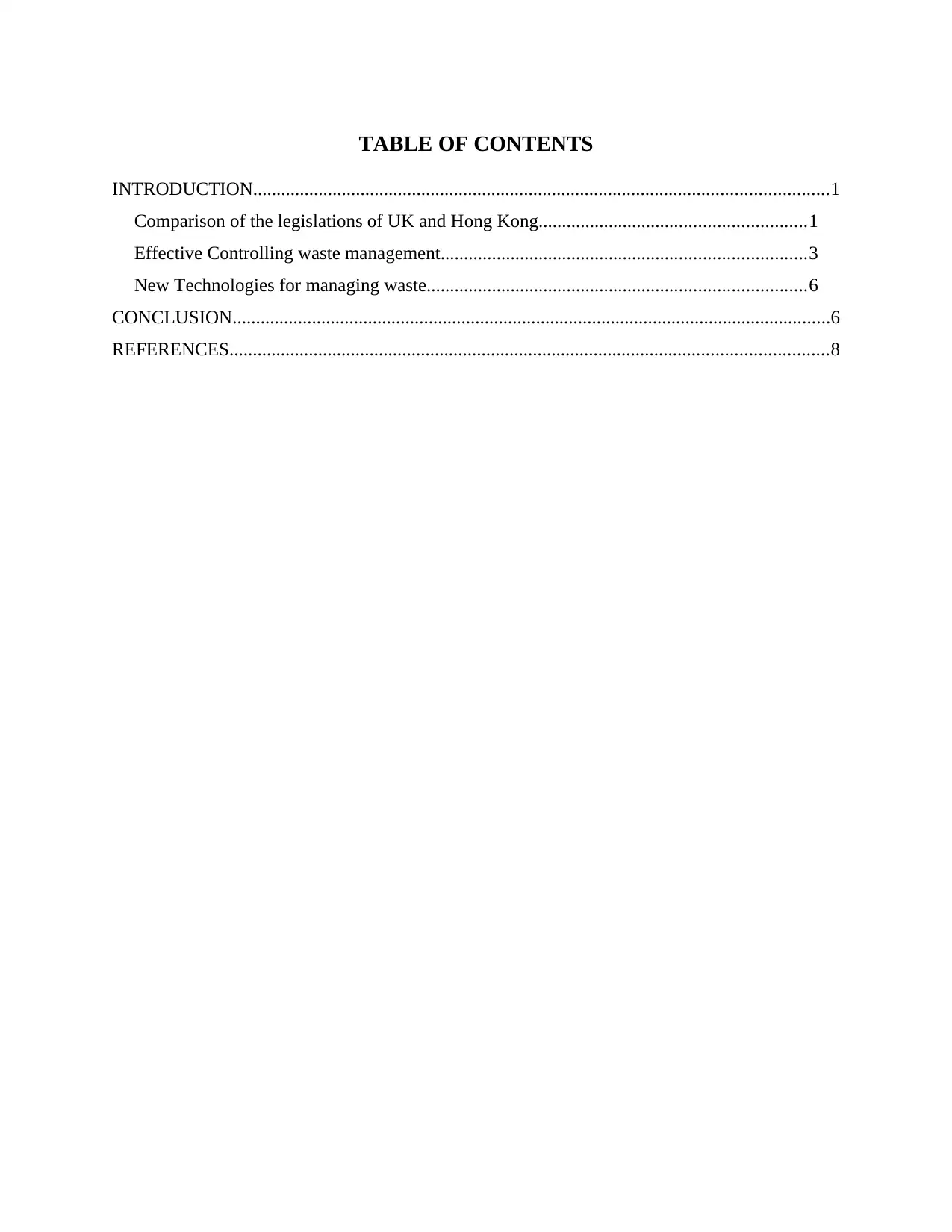
TABLE OF CONTENTS
INTRODUCTION...........................................................................................................................1
Comparison of the legislations of UK and Hong Kong.........................................................1
Effective Controlling waste management..............................................................................3
New Technologies for managing waste.................................................................................6
CONCLUSION................................................................................................................................6
REFERENCES................................................................................................................................8
INTRODUCTION...........................................................................................................................1
Comparison of the legislations of UK and Hong Kong.........................................................1
Effective Controlling waste management..............................................................................3
New Technologies for managing waste.................................................................................6
CONCLUSION................................................................................................................................6
REFERENCES................................................................................................................................8
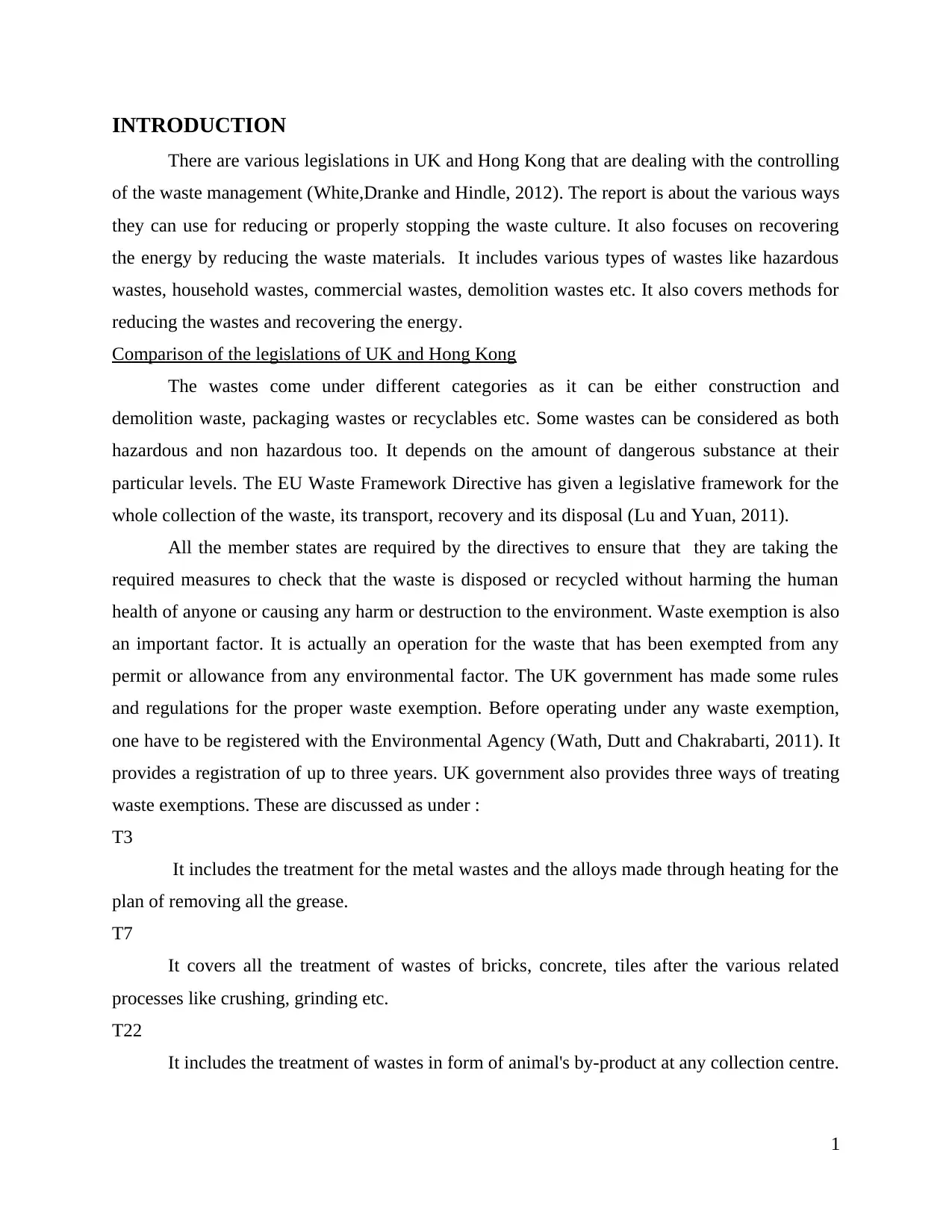
INTRODUCTION
There are various legislations in UK and Hong Kong that are dealing with the controlling
of the waste management (White,Dranke and Hindle, 2012). The report is about the various ways
they can use for reducing or properly stopping the waste culture. It also focuses on recovering
the energy by reducing the waste materials. It includes various types of wastes like hazardous
wastes, household wastes, commercial wastes, demolition wastes etc. It also covers methods for
reducing the wastes and recovering the energy.
Comparison of the legislations of UK and Hong Kong
The wastes come under different categories as it can be either construction and
demolition waste, packaging wastes or recyclables etc. Some wastes can be considered as both
hazardous and non hazardous too. It depends on the amount of dangerous substance at their
particular levels. The EU Waste Framework Directive has given a legislative framework for the
whole collection of the waste, its transport, recovery and its disposal (Lu and Yuan, 2011).
All the member states are required by the directives to ensure that they are taking the
required measures to check that the waste is disposed or recycled without harming the human
health of anyone or causing any harm or destruction to the environment. Waste exemption is also
an important factor. It is actually an operation for the waste that has been exempted from any
permit or allowance from any environmental factor. The UK government has made some rules
and regulations for the proper waste exemption. Before operating under any waste exemption,
one have to be registered with the Environmental Agency (Wath, Dutt and Chakrabarti, 2011). It
provides a registration of up to three years. UK government also provides three ways of treating
waste exemptions. These are discussed as under :
T3
It includes the treatment for the metal wastes and the alloys made through heating for the
plan of removing all the grease.
T7
It covers all the treatment of wastes of bricks, concrete, tiles after the various related
processes like crushing, grinding etc.
T22
It includes the treatment of wastes in form of animal's by-product at any collection centre.
1
There are various legislations in UK and Hong Kong that are dealing with the controlling
of the waste management (White,Dranke and Hindle, 2012). The report is about the various ways
they can use for reducing or properly stopping the waste culture. It also focuses on recovering
the energy by reducing the waste materials. It includes various types of wastes like hazardous
wastes, household wastes, commercial wastes, demolition wastes etc. It also covers methods for
reducing the wastes and recovering the energy.
Comparison of the legislations of UK and Hong Kong
The wastes come under different categories as it can be either construction and
demolition waste, packaging wastes or recyclables etc. Some wastes can be considered as both
hazardous and non hazardous too. It depends on the amount of dangerous substance at their
particular levels. The EU Waste Framework Directive has given a legislative framework for the
whole collection of the waste, its transport, recovery and its disposal (Lu and Yuan, 2011).
All the member states are required by the directives to ensure that they are taking the
required measures to check that the waste is disposed or recycled without harming the human
health of anyone or causing any harm or destruction to the environment. Waste exemption is also
an important factor. It is actually an operation for the waste that has been exempted from any
permit or allowance from any environmental factor. The UK government has made some rules
and regulations for the proper waste exemption. Before operating under any waste exemption,
one have to be registered with the Environmental Agency (Wath, Dutt and Chakrabarti, 2011). It
provides a registration of up to three years. UK government also provides three ways of treating
waste exemptions. These are discussed as under :
T3
It includes the treatment for the metal wastes and the alloys made through heating for the
plan of removing all the grease.
T7
It covers all the treatment of wastes of bricks, concrete, tiles after the various related
processes like crushing, grinding etc.
T22
It includes the treatment of wastes in form of animal's by-product at any collection centre.
1
⊘ This is a preview!⊘
Do you want full access?
Subscribe today to unlock all pages.

Trusted by 1+ million students worldwide
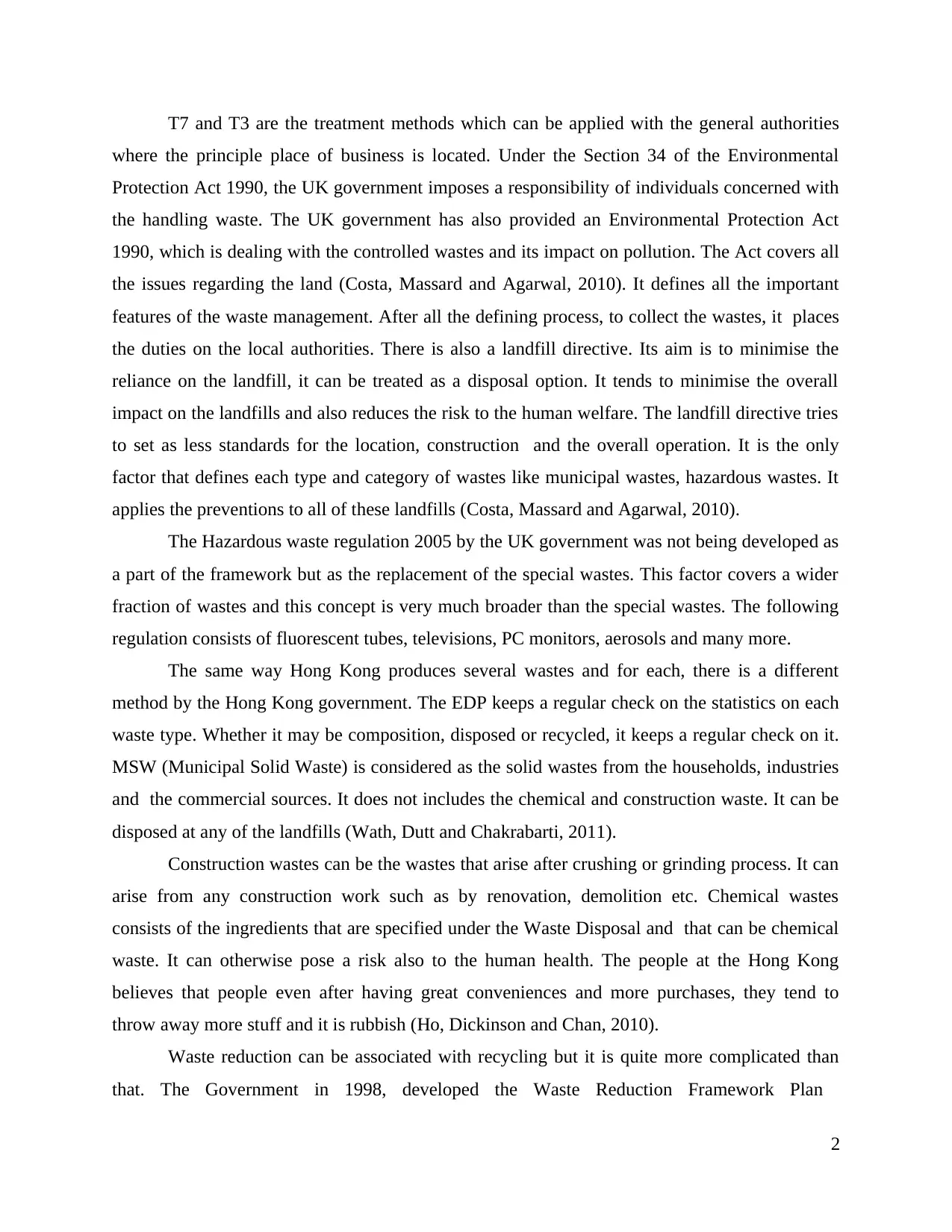
T7 and T3 are the treatment methods which can be applied with the general authorities
where the principle place of business is located. Under the Section 34 of the Environmental
Protection Act 1990, the UK government imposes a responsibility of individuals concerned with
the handling waste. The UK government has also provided an Environmental Protection Act
1990, which is dealing with the controlled wastes and its impact on pollution. The Act covers all
the issues regarding the land (Costa, Massard and Agarwal, 2010). It defines all the important
features of the waste management. After all the defining process, to collect the wastes, it places
the duties on the local authorities. There is also a landfill directive. Its aim is to minimise the
reliance on the landfill, it can be treated as a disposal option. It tends to minimise the overall
impact on the landfills and also reduces the risk to the human welfare. The landfill directive tries
to set as less standards for the location, construction and the overall operation. It is the only
factor that defines each type and category of wastes like municipal wastes, hazardous wastes. It
applies the preventions to all of these landfills (Costa, Massard and Agarwal, 2010).
The Hazardous waste regulation 2005 by the UK government was not being developed as
a part of the framework but as the replacement of the special wastes. This factor covers a wider
fraction of wastes and this concept is very much broader than the special wastes. The following
regulation consists of fluorescent tubes, televisions, PC monitors, aerosols and many more.
The same way Hong Kong produces several wastes and for each, there is a different
method by the Hong Kong government. The EDP keeps a regular check on the statistics on each
waste type. Whether it may be composition, disposed or recycled, it keeps a regular check on it.
MSW (Municipal Solid Waste) is considered as the solid wastes from the households, industries
and the commercial sources. It does not includes the chemical and construction waste. It can be
disposed at any of the landfills (Wath, Dutt and Chakrabarti, 2011).
Construction wastes can be the wastes that arise after crushing or grinding process. It can
arise from any construction work such as by renovation, demolition etc. Chemical wastes
consists of the ingredients that are specified under the Waste Disposal and that can be chemical
waste. It can otherwise pose a risk also to the human health. The people at the Hong Kong
believes that people even after having great conveniences and more purchases, they tend to
throw away more stuff and it is rubbish (Ho, Dickinson and Chan, 2010).
Waste reduction can be associated with recycling but it is quite more complicated than
that. The Government in 1998, developed the Waste Reduction Framework Plan
2
where the principle place of business is located. Under the Section 34 of the Environmental
Protection Act 1990, the UK government imposes a responsibility of individuals concerned with
the handling waste. The UK government has also provided an Environmental Protection Act
1990, which is dealing with the controlled wastes and its impact on pollution. The Act covers all
the issues regarding the land (Costa, Massard and Agarwal, 2010). It defines all the important
features of the waste management. After all the defining process, to collect the wastes, it places
the duties on the local authorities. There is also a landfill directive. Its aim is to minimise the
reliance on the landfill, it can be treated as a disposal option. It tends to minimise the overall
impact on the landfills and also reduces the risk to the human welfare. The landfill directive tries
to set as less standards for the location, construction and the overall operation. It is the only
factor that defines each type and category of wastes like municipal wastes, hazardous wastes. It
applies the preventions to all of these landfills (Costa, Massard and Agarwal, 2010).
The Hazardous waste regulation 2005 by the UK government was not being developed as
a part of the framework but as the replacement of the special wastes. This factor covers a wider
fraction of wastes and this concept is very much broader than the special wastes. The following
regulation consists of fluorescent tubes, televisions, PC monitors, aerosols and many more.
The same way Hong Kong produces several wastes and for each, there is a different
method by the Hong Kong government. The EDP keeps a regular check on the statistics on each
waste type. Whether it may be composition, disposed or recycled, it keeps a regular check on it.
MSW (Municipal Solid Waste) is considered as the solid wastes from the households, industries
and the commercial sources. It does not includes the chemical and construction waste. It can be
disposed at any of the landfills (Wath, Dutt and Chakrabarti, 2011).
Construction wastes can be the wastes that arise after crushing or grinding process. It can
arise from any construction work such as by renovation, demolition etc. Chemical wastes
consists of the ingredients that are specified under the Waste Disposal and that can be chemical
waste. It can otherwise pose a risk also to the human health. The people at the Hong Kong
believes that people even after having great conveniences and more purchases, they tend to
throw away more stuff and it is rubbish (Ho, Dickinson and Chan, 2010).
Waste reduction can be associated with recycling but it is quite more complicated than
that. The Government in 1998, developed the Waste Reduction Framework Plan
2
Paraphrase This Document
Need a fresh take? Get an instant paraphrase of this document with our AI Paraphraser
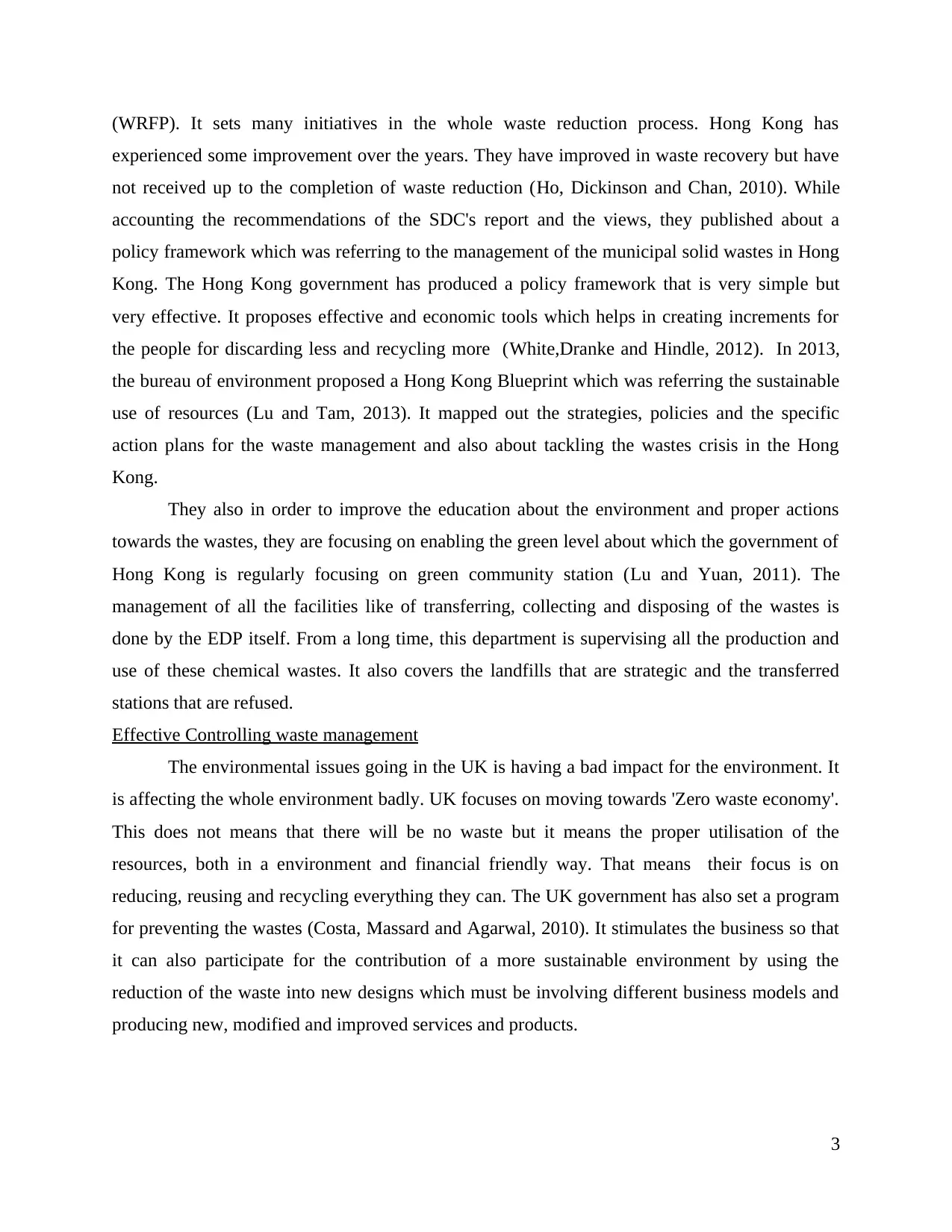
(WRFP). It sets many initiatives in the whole waste reduction process. Hong Kong has
experienced some improvement over the years. They have improved in waste recovery but have
not received up to the completion of waste reduction (Ho, Dickinson and Chan, 2010). While
accounting the recommendations of the SDC's report and the views, they published about a
policy framework which was referring to the management of the municipal solid wastes in Hong
Kong. The Hong Kong government has produced a policy framework that is very simple but
very effective. It proposes effective and economic tools which helps in creating increments for
the people for discarding less and recycling more (White,Dranke and Hindle, 2012). In 2013,
the bureau of environment proposed a Hong Kong Blueprint which was referring the sustainable
use of resources (Lu and Tam, 2013). It mapped out the strategies, policies and the specific
action plans for the waste management and also about tackling the wastes crisis in the Hong
Kong.
They also in order to improve the education about the environment and proper actions
towards the wastes, they are focusing on enabling the green level about which the government of
Hong Kong is regularly focusing on green community station (Lu and Yuan, 2011). The
management of all the facilities like of transferring, collecting and disposing of the wastes is
done by the EDP itself. From a long time, this department is supervising all the production and
use of these chemical wastes. It also covers the landfills that are strategic and the transferred
stations that are refused.
Effective Controlling waste management
The environmental issues going in the UK is having a bad impact for the environment. It
is affecting the whole environment badly. UK focuses on moving towards 'Zero waste economy'.
This does not means that there will be no waste but it means the proper utilisation of the
resources, both in a environment and financial friendly way. That means their focus is on
reducing, reusing and recycling everything they can. The UK government has also set a program
for preventing the wastes (Costa, Massard and Agarwal, 2010). It stimulates the business so that
it can also participate for the contribution of a more sustainable environment by using the
reduction of the waste into new designs which must be involving different business models and
producing new, modified and improved services and products.
3
experienced some improvement over the years. They have improved in waste recovery but have
not received up to the completion of waste reduction (Ho, Dickinson and Chan, 2010). While
accounting the recommendations of the SDC's report and the views, they published about a
policy framework which was referring to the management of the municipal solid wastes in Hong
Kong. The Hong Kong government has produced a policy framework that is very simple but
very effective. It proposes effective and economic tools which helps in creating increments for
the people for discarding less and recycling more (White,Dranke and Hindle, 2012). In 2013,
the bureau of environment proposed a Hong Kong Blueprint which was referring the sustainable
use of resources (Lu and Tam, 2013). It mapped out the strategies, policies and the specific
action plans for the waste management and also about tackling the wastes crisis in the Hong
Kong.
They also in order to improve the education about the environment and proper actions
towards the wastes, they are focusing on enabling the green level about which the government of
Hong Kong is regularly focusing on green community station (Lu and Yuan, 2011). The
management of all the facilities like of transferring, collecting and disposing of the wastes is
done by the EDP itself. From a long time, this department is supervising all the production and
use of these chemical wastes. It also covers the landfills that are strategic and the transferred
stations that are refused.
Effective Controlling waste management
The environmental issues going in the UK is having a bad impact for the environment. It
is affecting the whole environment badly. UK focuses on moving towards 'Zero waste economy'.
This does not means that there will be no waste but it means the proper utilisation of the
resources, both in a environment and financial friendly way. That means their focus is on
reducing, reusing and recycling everything they can. The UK government has also set a program
for preventing the wastes (Costa, Massard and Agarwal, 2010). It stimulates the business so that
it can also participate for the contribution of a more sustainable environment by using the
reduction of the waste into new designs which must be involving different business models and
producing new, modified and improved services and products.
3
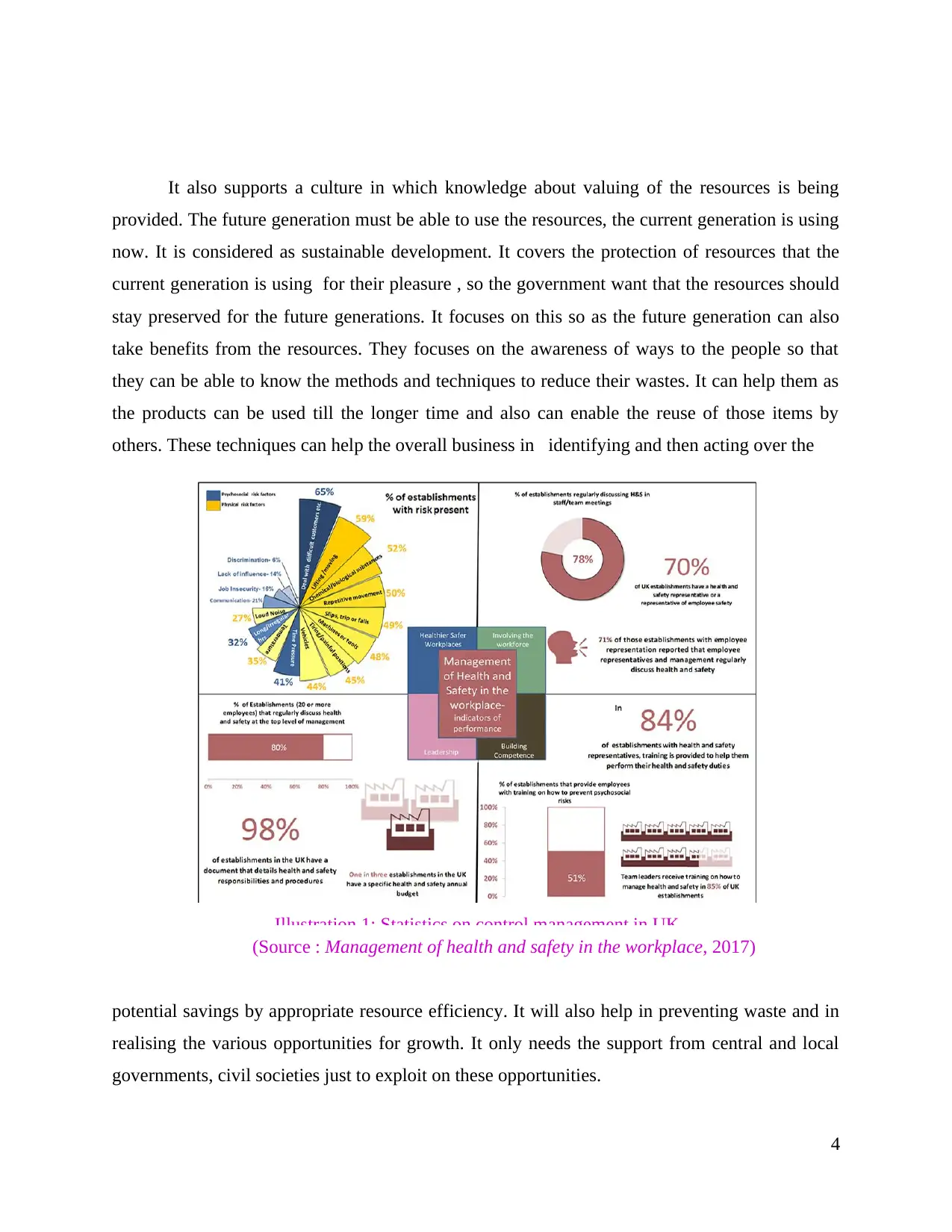
It also supports a culture in which knowledge about valuing of the resources is being
provided. The future generation must be able to use the resources, the current generation is using
now. It is considered as sustainable development. It covers the protection of resources that the
current generation is using for their pleasure , so the government want that the resources should
stay preserved for the future generations. It focuses on this so as the future generation can also
take benefits from the resources. They focuses on the awareness of ways to the people so that
they can be able to know the methods and techniques to reduce their wastes. It can help them as
the products can be used till the longer time and also can enable the reuse of those items by
others. These techniques can help the overall business in identifying and then acting over the
(Source : Management of health and safety in the workplace, 2017)
potential savings by appropriate resource efficiency. It will also help in preventing waste and in
realising the various opportunities for growth. It only needs the support from central and local
governments, civil societies just to exploit on these opportunities.
4
Illustration 1: Statistics on control management in UK
provided. The future generation must be able to use the resources, the current generation is using
now. It is considered as sustainable development. It covers the protection of resources that the
current generation is using for their pleasure , so the government want that the resources should
stay preserved for the future generations. It focuses on this so as the future generation can also
take benefits from the resources. They focuses on the awareness of ways to the people so that
they can be able to know the methods and techniques to reduce their wastes. It can help them as
the products can be used till the longer time and also can enable the reuse of those items by
others. These techniques can help the overall business in identifying and then acting over the
(Source : Management of health and safety in the workplace, 2017)
potential savings by appropriate resource efficiency. It will also help in preventing waste and in
realising the various opportunities for growth. It only needs the support from central and local
governments, civil societies just to exploit on these opportunities.
4
Illustration 1: Statistics on control management in UK
⊘ This is a preview!⊘
Do you want full access?
Subscribe today to unlock all pages.

Trusted by 1+ million students worldwide
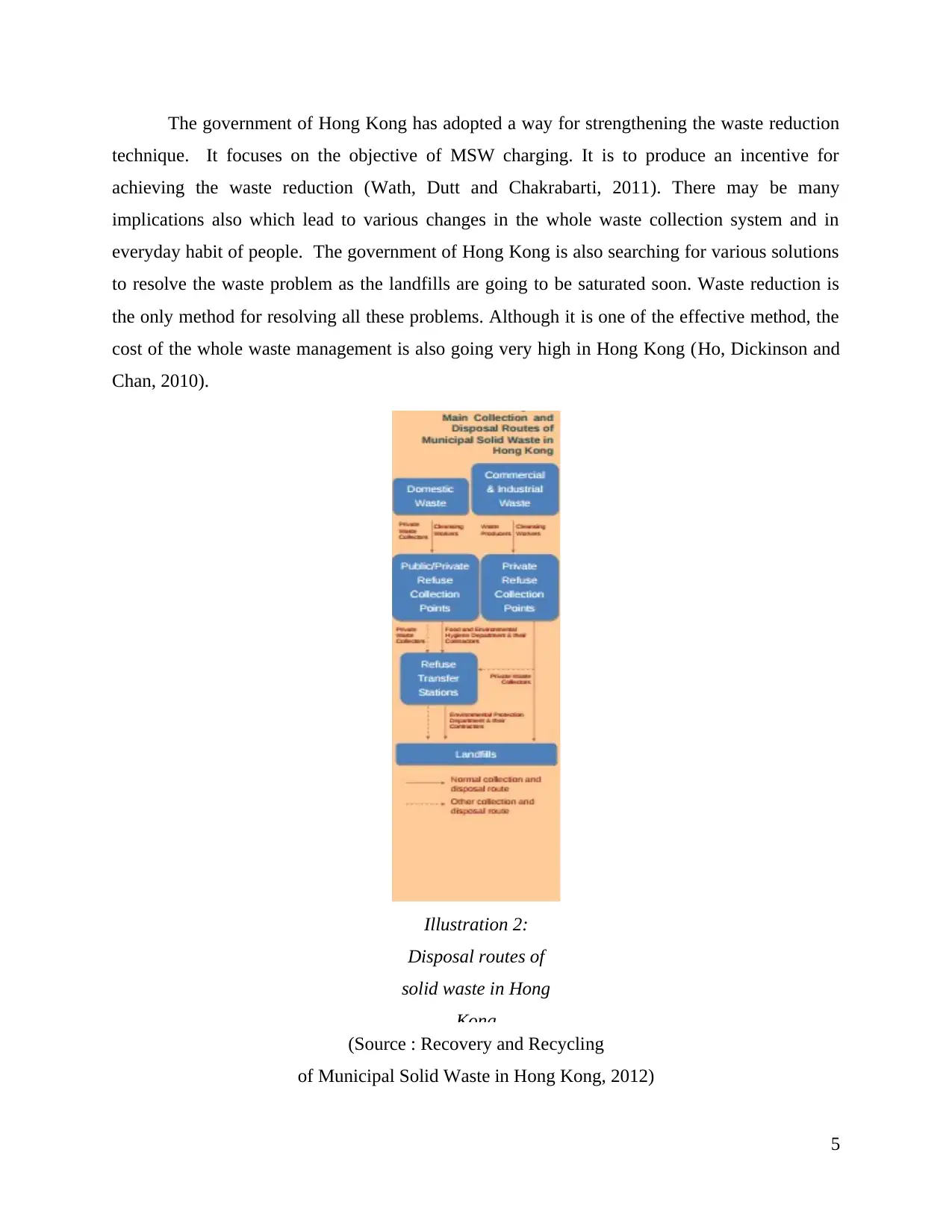
The government of Hong Kong has adopted a way for strengthening the waste reduction
technique. It focuses on the objective of MSW charging. It is to produce an incentive for
achieving the waste reduction (Wath, Dutt and Chakrabarti, 2011). There may be many
implications also which lead to various changes in the whole waste collection system and in
everyday habit of people. The government of Hong Kong is also searching for various solutions
to resolve the waste problem as the landfills are going to be saturated soon. Waste reduction is
the only method for resolving all these problems. Although it is one of the effective method, the
cost of the whole waste management is also going very high in Hong Kong (Ho, Dickinson and
Chan, 2010).
(Source : Recovery and Recycling
of Municipal Solid Waste in Hong Kong, 2012)
5
Illustration 2:
Disposal routes of
solid waste in Hong
Kong
technique. It focuses on the objective of MSW charging. It is to produce an incentive for
achieving the waste reduction (Wath, Dutt and Chakrabarti, 2011). There may be many
implications also which lead to various changes in the whole waste collection system and in
everyday habit of people. The government of Hong Kong is also searching for various solutions
to resolve the waste problem as the landfills are going to be saturated soon. Waste reduction is
the only method for resolving all these problems. Although it is one of the effective method, the
cost of the whole waste management is also going very high in Hong Kong (Ho, Dickinson and
Chan, 2010).
(Source : Recovery and Recycling
of Municipal Solid Waste in Hong Kong, 2012)
5
Illustration 2:
Disposal routes of
solid waste in Hong
Kong
Paraphrase This Document
Need a fresh take? Get an instant paraphrase of this document with our AI Paraphraser

The UK government is making it easy for the people to recycle the waste more and more.
It helps in reducing the fraction of waste that is being sent for the landfilling and for the
combustion activities. Also, it preserves all the natural resources like water, minerals, timber etc.
This will help the country to stay safe from pollution and all the related activities. As the
requirement for collecting the raw material decreases, pollution is being prevented by it. The gas
emissions that led to the global climatic change are contributed by the reduced green house
effect. The government is focusing on improving the overall quality of the recycled collected
from different places (Wath, Dutt and Chakrabarti, 2011).
New Technologies for managing waste
There are various techniques which both the countries can implement. Various techniques
are there for controlling the wastes such as Anaerobic digestion, Bio drying, Gasification, Gas
Plasma etc. Anaerobic digestion is a group of activities in which breaking down of
microorganisms is being done in the absence of oxygen (Costa, Massard and Agarwal, 2010).
This process is specially used in domestic or industrial purposes for managing the wastes or for
producing fuels. UK government has also developed Gasification for the reduction of wastes. It
is a process in which conversion of fossil fuels or organic materials into carbon monoxide or
carbon dioxide. Reaction of the metal at more than 7000C without the combustion is achieved.
The mixture of gas that acts as the resulting is called syngas.
6
It helps in reducing the fraction of waste that is being sent for the landfilling and for the
combustion activities. Also, it preserves all the natural resources like water, minerals, timber etc.
This will help the country to stay safe from pollution and all the related activities. As the
requirement for collecting the raw material decreases, pollution is being prevented by it. The gas
emissions that led to the global climatic change are contributed by the reduced green house
effect. The government is focusing on improving the overall quality of the recycled collected
from different places (Wath, Dutt and Chakrabarti, 2011).
New Technologies for managing waste
There are various techniques which both the countries can implement. Various techniques
are there for controlling the wastes such as Anaerobic digestion, Bio drying, Gasification, Gas
Plasma etc. Anaerobic digestion is a group of activities in which breaking down of
microorganisms is being done in the absence of oxygen (Costa, Massard and Agarwal, 2010).
This process is specially used in domestic or industrial purposes for managing the wastes or for
producing fuels. UK government has also developed Gasification for the reduction of wastes. It
is a process in which conversion of fossil fuels or organic materials into carbon monoxide or
carbon dioxide. Reaction of the metal at more than 7000C without the combustion is achieved.
The mixture of gas that acts as the resulting is called syngas.
6

(Source : Construction and demolition waste, 2011)
Another method, Gas Plasma is being applied by the Hong Kong government. It is
similar to the gasification which is being followed by syngas plasma itself. The government has
set a framework which includes a series of policies and measures for tackling the waste problem.
It all has been done for achieving some specific targets. Their focus on minimising the amount
of municipal solid waste (MSW) by 1% per annum has been successfully implemented till now.
They believe first in appropriate collection of waste and then in proper disposal of it. This way
can efficiently help the city in waste reduction and preventing sources for the future use. The
Hong Kong government has observed various positive outcomes after the implementation of this
technique.
CONCLUSION
It has been concluded from the report that the UK and Hong Kong government is facing
many issues with with the whole waste management system. It consists of various legislations
that had been implemented by the UK government and the Hong Kong government for proper
reducing or recycling of wastes. Their forte is to recover the energy by decreasing or stopping
the ways of generating wastes. Various new technologies have also been implemented by both
7
Illustration 3: Statistics on sources of wastes.
Another method, Gas Plasma is being applied by the Hong Kong government. It is
similar to the gasification which is being followed by syngas plasma itself. The government has
set a framework which includes a series of policies and measures for tackling the waste problem.
It all has been done for achieving some specific targets. Their focus on minimising the amount
of municipal solid waste (MSW) by 1% per annum has been successfully implemented till now.
They believe first in appropriate collection of waste and then in proper disposal of it. This way
can efficiently help the city in waste reduction and preventing sources for the future use. The
Hong Kong government has observed various positive outcomes after the implementation of this
technique.
CONCLUSION
It has been concluded from the report that the UK and Hong Kong government is facing
many issues with with the whole waste management system. It consists of various legislations
that had been implemented by the UK government and the Hong Kong government for proper
reducing or recycling of wastes. Their forte is to recover the energy by decreasing or stopping
the ways of generating wastes. Various new technologies have also been implemented by both
7
Illustration 3: Statistics on sources of wastes.
⊘ This is a preview!⊘
Do you want full access?
Subscribe today to unlock all pages.

Trusted by 1+ million students worldwide
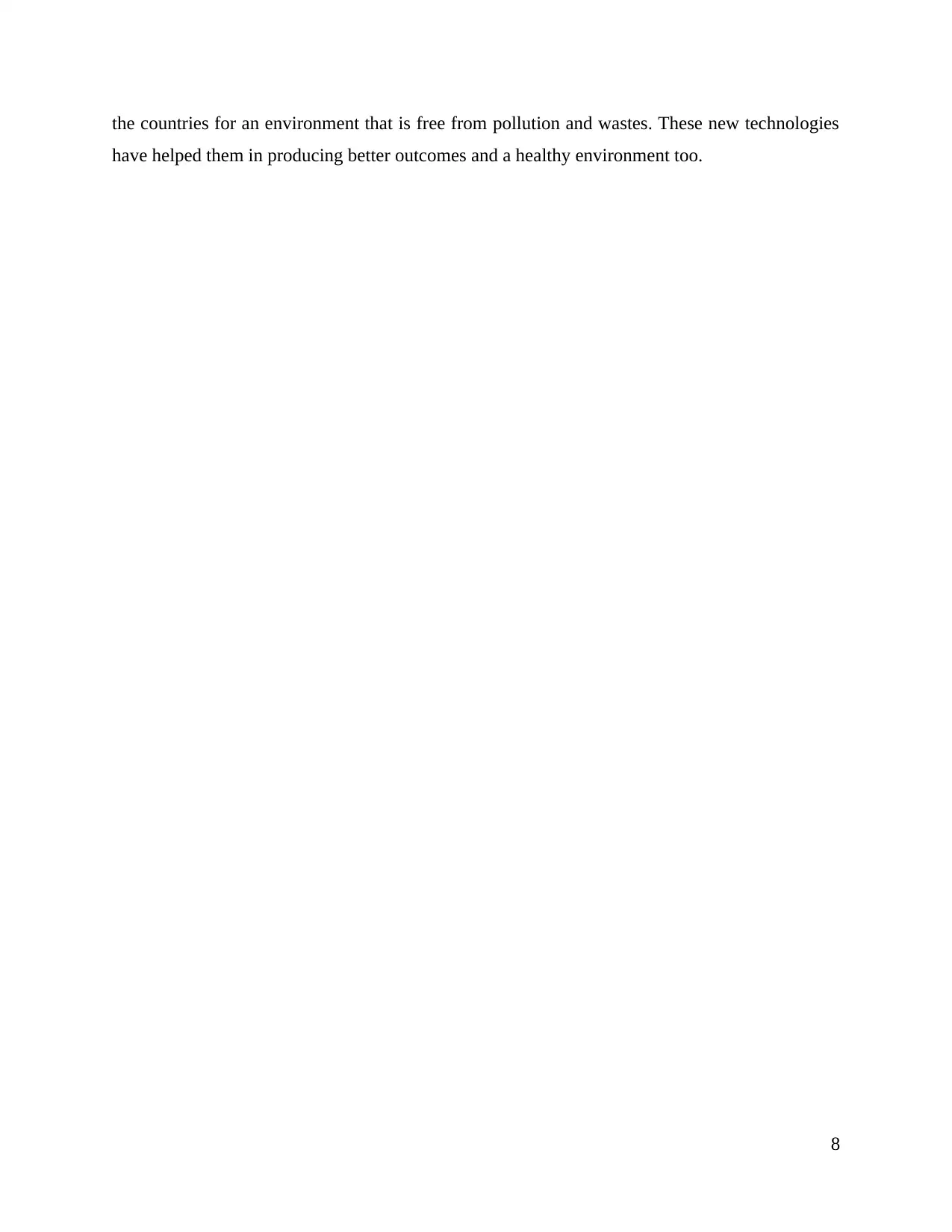
the countries for an environment that is free from pollution and wastes. These new technologies
have helped them in producing better outcomes and a healthy environment too.
8
have helped them in producing better outcomes and a healthy environment too.
8
Paraphrase This Document
Need a fresh take? Get an instant paraphrase of this document with our AI Paraphraser

REFERENCES
Books and Journals
Costa, I., Massard, G. and Agarwal, A., 2010. Waste management policies for industrial
symbiosis development: case studies in European countries. Journal of Cleaner
Production. 18(8). pp.815-822.
Costa, I., Massard, G. and Agarwal, A., 2010. Waste management policies for industrial
symbiosis development: case studies in European countries. Journal of Cleaner
Production. 18(8). pp.815-822.
Ho, G.T.S., Choy, K.L., Lam, C.H.Y. and Wong, D.W., 2012. Factors influencing
implementation of reverse logistics: a survey among Hong Kong businesses. Measuring
Business Excellence. 16(3). pp.29-46.
Ho, L. W., Dickinson, N. M. and Chan, G., 2010, February. Green procurement in the Asian
public sector and the Hong Kong private sector. In Natural Resources Forum (Vol. 34,
No. 1, pp. 24-38). Blackwell Publishing Ltd.
Lu, W. and Tam, V. W., 2013. Construction waste management policies and their effectiveness
in Hong Kong: A longitudinal review. Renewable and sustainable energy reviews. 23.
pp.214-223.
Lu, W. and Yuan, H., 2011. A framework for understanding waste management studies in
construction. Waste Management. 31(6). pp.1252-1260.
Nagapan, S., Rahman, I.A., Asmi, A., Memon, A.H. and Latif, I., 2012, December. Issues on
construction waste: the need for sustainable waste management. In Humanities, Science
and Engineering (CHUSER). 2012 IEEE Colloquium on (pp. 325-330). IEEE.
Osmani, M., 2012. Construction waste minimization in the UK: current pressures for change and
approaches. Procedia-Social and Behavioral Sciences. 40. pp.37-40.
Osmani, M., 2012. Construction waste minimization in the UK: current pressures for change and
approaches. Procedia-Social and Behavioral Sciences. 40. pp.37-40.
Wath, S. B., Dutt, P. S. and Chakrabarti, T., 2011. E-waste scenario in India, its management and
implications. Environmental monitoring and assessment. 172(1). pp.249-262.
White, P., Dranke, M. and Hindle, P., 2012. Integrated solid waste management: a lifecycle
inventory. Springer Science & Business Media.
9
Books and Journals
Costa, I., Massard, G. and Agarwal, A., 2010. Waste management policies for industrial
symbiosis development: case studies in European countries. Journal of Cleaner
Production. 18(8). pp.815-822.
Costa, I., Massard, G. and Agarwal, A., 2010. Waste management policies for industrial
symbiosis development: case studies in European countries. Journal of Cleaner
Production. 18(8). pp.815-822.
Ho, G.T.S., Choy, K.L., Lam, C.H.Y. and Wong, D.W., 2012. Factors influencing
implementation of reverse logistics: a survey among Hong Kong businesses. Measuring
Business Excellence. 16(3). pp.29-46.
Ho, L. W., Dickinson, N. M. and Chan, G., 2010, February. Green procurement in the Asian
public sector and the Hong Kong private sector. In Natural Resources Forum (Vol. 34,
No. 1, pp. 24-38). Blackwell Publishing Ltd.
Lu, W. and Tam, V. W., 2013. Construction waste management policies and their effectiveness
in Hong Kong: A longitudinal review. Renewable and sustainable energy reviews. 23.
pp.214-223.
Lu, W. and Yuan, H., 2011. A framework for understanding waste management studies in
construction. Waste Management. 31(6). pp.1252-1260.
Nagapan, S., Rahman, I.A., Asmi, A., Memon, A.H. and Latif, I., 2012, December. Issues on
construction waste: the need for sustainable waste management. In Humanities, Science
and Engineering (CHUSER). 2012 IEEE Colloquium on (pp. 325-330). IEEE.
Osmani, M., 2012. Construction waste minimization in the UK: current pressures for change and
approaches. Procedia-Social and Behavioral Sciences. 40. pp.37-40.
Osmani, M., 2012. Construction waste minimization in the UK: current pressures for change and
approaches. Procedia-Social and Behavioral Sciences. 40. pp.37-40.
Wath, S. B., Dutt, P. S. and Chakrabarti, T., 2011. E-waste scenario in India, its management and
implications. Environmental monitoring and assessment. 172(1). pp.249-262.
White, P., Dranke, M. and Hindle, P., 2012. Integrated solid waste management: a lifecycle
inventory. Springer Science & Business Media.
9
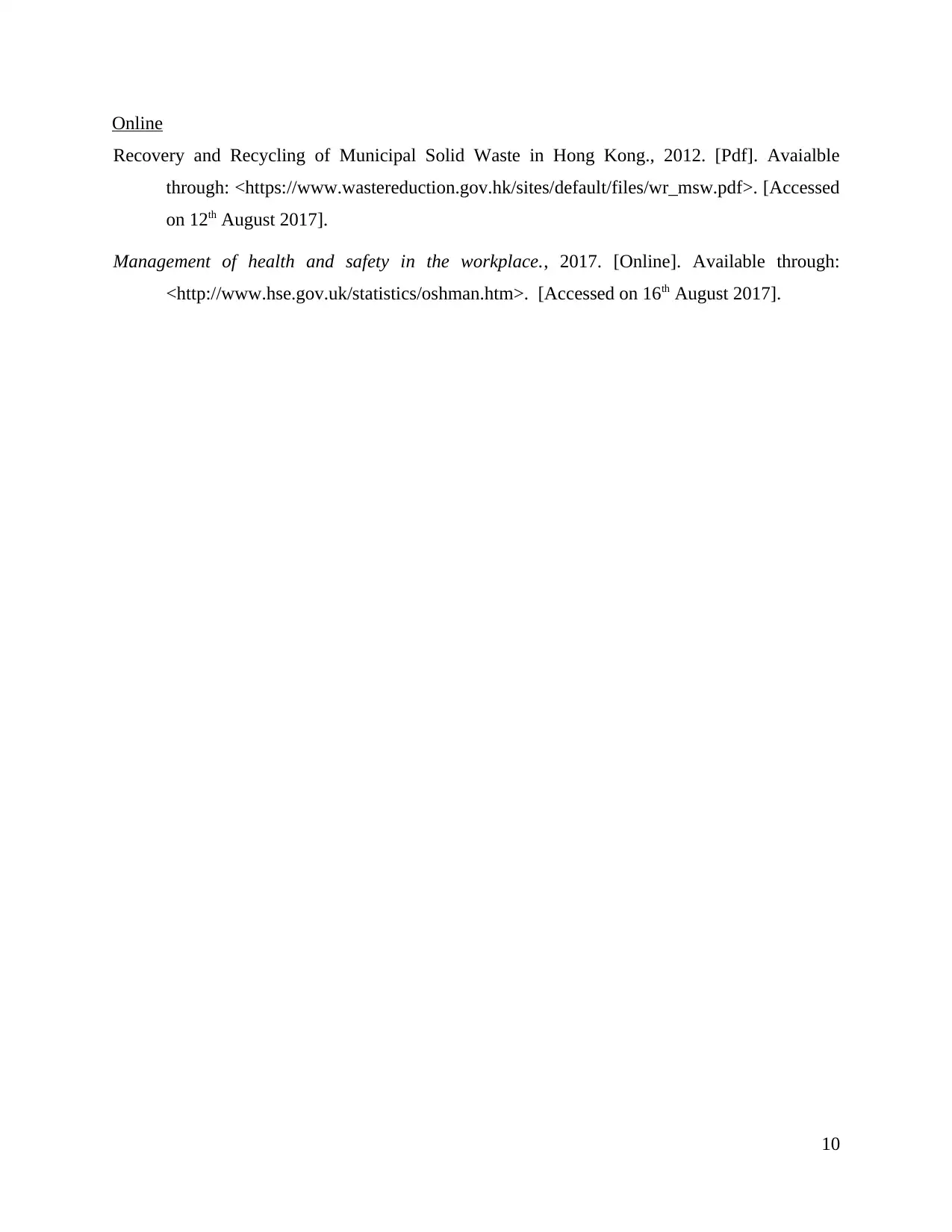
Online
Recovery and Recycling of Municipal Solid Waste in Hong Kong., 2012. [Pdf]. Avaialble
through: <https://www.wastereduction.gov.hk/sites/default/files/wr_msw.pdf>. [Accessed
on 12th August 2017].
Management of health and safety in the workplace., 2017. [Online]. Available through:
<http://www.hse.gov.uk/statistics/oshman.htm>. [Accessed on 16th August 2017].
10
Recovery and Recycling of Municipal Solid Waste in Hong Kong., 2012. [Pdf]. Avaialble
through: <https://www.wastereduction.gov.hk/sites/default/files/wr_msw.pdf>. [Accessed
on 12th August 2017].
Management of health and safety in the workplace., 2017. [Online]. Available through:
<http://www.hse.gov.uk/statistics/oshman.htm>. [Accessed on 16th August 2017].
10
⊘ This is a preview!⊘
Do you want full access?
Subscribe today to unlock all pages.

Trusted by 1+ million students worldwide
1 out of 12
Related Documents
Your All-in-One AI-Powered Toolkit for Academic Success.
+13062052269
info@desklib.com
Available 24*7 on WhatsApp / Email
![[object Object]](/_next/static/media/star-bottom.7253800d.svg)
Unlock your academic potential
Copyright © 2020–2025 A2Z Services. All Rights Reserved. Developed and managed by ZUCOL.




